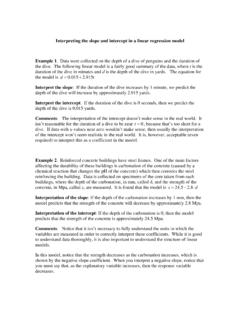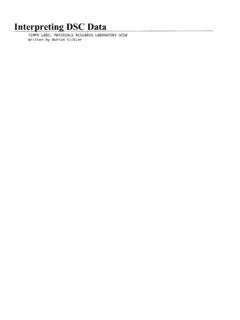Transcription of Lecture 10: Logistical Regression II— Multinomial Data
1 Lecture 10: Logistical Regression II Multinomial DataProf. Sharyn O Halloran Sustainable Development U9611 Econometrics IILogit vs. Probit Review Use with a dichotomous dependent variable Need a link function F(Y) going from the original Y to continuous Y Probit: F(Y) = -1(Y) Logit: F(Y) = log[Y/(1-Y)] Do the Regression and transform the findings back from Y to Y, interpreted as a probability Unlike linear Regression , the impact of an independent variable X depends on its value Andthe values of all other independent variablesClassical vs. Logistic Regression data Structure: continuous vs. discrete Logistic/Probit Regression is used when the dependent variable is binary or dichotomous. Different assumptions between traditional Regression and logistic Regression The population means of the dependent variables at each level of the independent variable are not on a straight line, , no linearity.
2 The variance of the errors are not constant, , no homogeneity of variance. The errors are not normally distributed, , no Regression Assumptions model is correctly specified, , The true conditional probabilities are a logistic function of the independent variables; No important variables are omitted; No extraneous variables are included; and The independent variables are measured without cases are independent. independent variables are not linear combinations of each other. Perfect multicollinearity makes estimation impossible, While strong multicollinearity makes estimates imprecise. About Logistic Regression It uses a maximum likelihood estimation rather than the least squares estimation used in traditional multiple Regression .
3 The general form of the distribution is assumed. Starting values of the estimated parameters are used and the likelihood that the sample came from a population with those parameters is computed. The values of the estimated parameters are adjusted iteratively until the maximum likelihood value for the estimated parameters is obtained. That is, maximum likelihood approaches try to find estimates of parameters that make the data actually observed "most likely." interpreting Logistic Coefficients Logistic slope coefficients can be interpreted as the effect of a unit of change in the X variable on the predicted logitswith the other variables in the model held constant. That is, how a one unit change in X effects the log of the odds when the other variables in the model held Odds Ratios Odds ratios in logistic Regression can be interpreted as the effect of a one unit of change in X in the predicted odds ratiowith the other variables in the model held Odds Ratios An important property of odds ratios is that they are constant.
4 It does not matter what values the other independent variables take on. For instance, say you estimate the following logistic Regression model: + .1685 x1+ .0039 x2 The effect of the odds of a 1-unit increase in x1is exp(.1685) = Meaning the odds increase by 18% Incrementing x1increases the odds by 18% regardless of the value of x2(0, 1000, etc.) Example: Admissions data 20 observations of admission into a graduate program data collected includes whether admitted, gender (1 if male) and the student s aptitude on a 10 point aptitudeAdmissions Example Calculating the Odds Ratio Example: admissions to a graduate program Assume 70% of the males and 30% of the females are admitted in a given year Let P equal the probability a male is admitted.
5 Let Q equal the probability a female is admitted. Odds males are admitted: odds(M) = P/(1-P) = .7/.3 = Odds females are admitted: odds(F) = Q/(1-Q) = .3/.7 = The odds ratio for male vs. female admits is then odds(M)/odds(F) = = The odds of being admitted to the program are about times greater for males than 1: Categorical Independent logit admit genderLogit estimates Number of obs = 20LR chi2(1) = > chi2 = likelihood = Pseudo R2 = | Coef. Std. Err. z P>|z| [95% Conf. Interval]---------+--------------------- ---------------------------------------- -------gender | .9759001 |.
6 6900656 . exp(_b[gender]+_b[_cons])/(1+exp(_b[gend er]+_b[_cons])).7. dis exp(_b[_cons])/(1+exp(_b[_cons])).3 Formula to back out Y from logit estimates: ()() XXYexp1exp+=Ex. 1: Categorical Independent Variablelogit admit gender, orLogit estimates Number of obs = 20LR chi2(1) = > chi2 = likelihood = Pseudo R2 = | Odds Ratio Std. Err. z P>|z| [95% Conf. Interval]---------+--------------------- ---------------------------------------- -------gender | .8040183 get the results in terms of odds ratios:Translatesoriginal logit coefficients to odds ratio on genderSame as the odds ratio we calculated by hand aboveEx.
7 1: Categorical Independent Variablelogit admit gender, orLogit estimates Number of obs = 20LR chi2(1) = > chi2 = likelihood = Pseudo R2 = | Odds Ratio Std. Err. z P>|z| [95% Conf. Interval]---------+--------------------- ---------------------------------------- -------gender | .8040183 get the results in terms of odds ratios:So is the exponentiated coefficient Don t confuse this with the logit coefficient ( )Ex. 1: Categorical Independent Variablelogit admit gender, orLogit estimates Number of obs = 20LR chi2(1) = > chi2 = likelihood = Pseudo R2 = | Odds Ratio Std.
8 Err. z P>|z| [95% Conf. Interval]---------+--------------------- ---------------------------------------- -------gender | .8040183 get the results in terms of odds ratios:That is, exp( ) = 2: Continuous Independent admit aptIteration 0: log likelihood = 1: log likelihood = 2: log likelihood = 3: log likelihood = 4: log likelihood = estimates Number of obs = 20LR chi2(1) = > chi2 = likelihood = Pseudo R2 = | Coef. Std. Err. z P>|z| [95% Conf. Interval]---------+--------------------- ---------------------------------------- -------apt | .9455112.
9 422872 .1166974 | at the probability of being admitted to graduate school given the candidate s aptitudeEx. 2: Continuous Independent admit aptIteration 0: log likelihood = 1: log likelihood = 2: log likelihood = 3: log likelihood = 4: log likelihood = estimates Number of obs = 20LR chi2(1) = > chi2 = likelihood = Pseudo R2 = | Coef. Std. Err. z P>|z| [95% Conf. Interval]---------+--------------------- ---------------------------------------- -------apt | .9455112 .422872 .1166974 | at the probability of being admitted to graduate school given the candidate s aptitudeAptitude is positive and significantly related to being admitted into the graduate programEx.
10 2: Continuous Independent admit apt, orLogit estimates Number of obs = 20LR chi2(1) = > chi2 = likelihood = Pseudo R2 = | Odds Ratio Std. Err. z P>|z| [95% Conf. Interval]---------+--------------------- ---------------------------------------- -------apt | means:()()()() |admitPr1apt|admitPr1apt|admitPr11apt|ad mitPr= + +Ex. 2: Continuous Independent (admit)0246810aptitu de. predict p. line p aptitude, sortEx. 2: Continuous Independent (admit)0246810aptitu de. predict p. line p aptitude, sort50% chance of being admittedExample 3: Categorical & Continuous Independent Variableslogit admit gender aptLogit estimates Number of obs = 20LR chi2(2) = > chi2 = likelihood = Pseudo R2 = | Coef.














